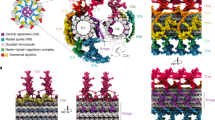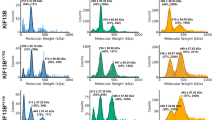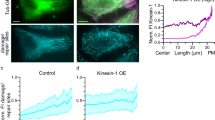Abstract
In most eukaryotic cells microtubules undergo post-translational modifications such as acetylation of α-tubulin on lysine 40, a widespread modification restricted to a subset of microtubules that turns over slowly1. This subset of stable microtubules accumulates in cell protrusions2 and regulates cell polarization3, migration and invasion4,5,6,7. However, mechanisms restricting acetylation to these microtubules are unknown. Here we report that clathrin-coated pits (CCPs) control microtubule acetylation through a direct interaction of the α-tubulin acetyltransferase αTAT1 (refs 8, 9) with the clathrin adaptor AP2. We observe that about one-third of growing microtubule ends contact and pause at CCPs and that loss of CCPs decreases lysine 40 acetylation levels. We show that αTAT1 localizes to CCPs through a direct interaction with AP2 that is required for microtubule acetylation. In migrating cells, the polarized orientation of acetylated microtubules correlates with CCP accumulation at the leading edge10, and interaction of αTAT1 with AP2 is required for directional migration. We conclude that microtubules contacting CCPs become acetylated by αTAT1. In migrating cells, this mechanism ensures the acetylation of microtubules oriented towards the leading edge, thus promoting directional cell locomotion and chemotaxis.
This is a preview of subscription content, access via your institution
Access options
Subscribe to this journal
Receive 51 print issues and online access
$199.00 per year
only $3.90 per issue
Buy this article
- Purchase on Springer Link
- Instant access to full article PDF
Prices may be subject to local taxes which are calculated during checkout




Similar content being viewed by others
References
Perdiz, D., Mackeh, R., Pous, C. & Baillet, A. The ins and outs of tubulin acetylation: more than just a post-translational modification? Cell. Signal. 23, 763–771 (2011)
Wloga, D. & Gaertig, J. Post-translational modifications of microtubules. J. Cell Sci. 123, 3447–3455 (2010)
Witte, H., Neukirchen, D. & Bradke, F. Microtubule stabilization specifies initial neuronal polarization. J. Cell Biol. 180, 619–632 (2008)
Castro-Castro, A., Janke, C., Montagnac, G., Paul-Gilloteaux, P. & Chavrier, P. ATAT1/MEC-17 acetyltransferase and HDAC6 deacetylase control a balance of acetylation of alpha-tubulin and cortactin and regulate MT1-MMP trafficking and breast tumor cell invasion. Eur. J. Cell Biol. 91, 950–960 (2012)
Hubbert, C. et al. HDAC6 is a microtubule-associated deacetylase. Nature 417, 455–458 (2002)
Rey, M., Irondelle, M., Waharte, F., Lizarraga, F. & Chavrier, P. HDAC6 is required for invadopodia activity and invasion by breast tumor cells. Eur. J. Cell Biol. 90, 128–135 (2011)
Tran, A. D. et al. HDAC6 deacetylation of tubulin modulates dynamics of cellular adhesions. J. Cell Sci. 120, 1469–1479 (2007)
Akella, J. S. et al. MEC-17 is an α-tubulin acetyltransferase. Nature 467, 218–222 (2010)
Shida, T., Cueva, J. G., Xu, Z., Goodman, M. B. & Nachury, M. V. The major α-tubulin K40 acetyltransferase αTAT1 promotes rapid ciliogenesis and efficient mechanosensation. Proc. Natl Acad. Sci. USA 107, 21517–21522 (2010)
Rappoport, J. Z. & Simon, S. M. Real-time analysis of clathrin-mediated endocytosis during cell migration. J. Cell Sci. 116, 847–855 (2003)
Caswell, P. T. et al. Rab25 associates with α5β1 integrin to promote invasive migration in 3D microenvironments. Dev. Cell 13, 496–510 (2007)
Howes, M. T. et al. Clathrin-independent carriers form a high capacity endocytic sorting system at the leading edge of migrating cells. J. Cell Biol. 190, 675–691 (2010)
Rappoport, J. Z., Taha, B. W. & Simon, S. M. Movement of plasma-membrane-associated clathrin spots along the microtubule cytoskeleton. Traffic 4, 460–467 (2003)
Gundersen, G. G. Microtubule capture: IQGAP and CLIP-170 expand the repertoire. Curr. Biol. 12, 645–647 (2002)
Hinrichsen, L., Harborth, J., Andrees, L., Weber, K. & Ungewickell, E. J. Effect of clathrin heavy chain- and α-adaptin-specific small inhibitory RNAs on endocytic accessory proteins and receptor trafficking in HeLa cells. J. Biol. Chem. 278, 45160–45170 (2003)
Ferguson, S. M. et al. Coordinated actions of actin and BAR proteins upstream of dynamin at endocytic clathrin-coated pits. Dev. Cell 17, 811–822 (2009)
Tanabe, K. & Takei, K. Dynamic instability of microtubules requires dynamin 2 and is impaired in a Charcot-Marie-Tooth mutant. J. Cell Biol. 185, 939–948 (2009)
Collins, B. M., McCoy, A. J., Kent, H. M., Evans, P. R. & Owen, D. J. Molecular architecture and functional model of the endocytic AP2 complex. Cell 109, 523–535 (2002)
Bulinski, J. C., Richards, J. E. & Piperno, G. Posttranslational modifications of alpha tubulin: detyrosination and acetylation differentiate populations of interphase microtubules in cultured cells. J. Cell Biol. 106, 1213–1220 (1988)
Chabin-Brion, K. et al. The Golgi complex is a microtubule-organizing organelle. Mol. Biol. Cell 12, 2047–2060 (2001)
Efimov, A. et al. Asymmetric CLASP-dependent nucleation of noncentrosomal microtubules at the trans-Golgi network. Dev. Cell 12, 917–930 (2007)
Gundersen, G. G. & Bulinski, J. C. Selective stabilization of microtubules oriented toward the direction of cell migration. Proc. Natl Acad. Sci. USA 85, 5946–5950 (1988)
Watanabe, T., Noritake, J. & Kaibuchi, K. Regulation of microtubules in cell migration. Trends Cell Biol. 15, 76–83 (2005)
Ezratty, E. J., Bertaux, C., Marcantonio, E. E. & Gundersen, G. G. Clathrin mediates integrin endocytosis for focal adhesion disassembly in migrating cells. J. Cell Biol. 187, 733–747 (2009)
Rowe, R. G. & Weiss, S. J. Breaching the basement membrane: who, when and how? Trends Cell Biol. 18, 560–574 (2008)
Condeelis, J. & Pollard, J. W. Macrophages: obligate partners for tumor cell migration, invasion, and metastasis. Cell 124, 263–266 (2006)
de Chaumont, F. et al. Icy: an open bioimage informatics platform for extended reproducible research. Nature Methods 9, 690–696 (2012)
de Chaumont, F., Dallongeville, S. & Olivo-Marin, J. C. ICY: a new open-source community image processing software. IEEE International Symposium on Biomedical Imaging (2011)
Kaplan, O. I. et al. The AP-1 clathrin adaptor facilitates cilium formation and functions with RAB-8 in C. elegans ciliary membrane transport. J. Cell Sci. 123, 3966–3977 (2010)
Montagnac, G. et al. Decoupling of activation and effector binding underlies ARF6 priming of fast endocytic recycling. Curr. Biol. 21, 574–579 (2011)
Campbell, C. H., Fine, R. E., Squicciarini, J. & Rome, L. H. Coated vesicles from rat liver and calf brain contain cryptic mannose 6-phosphate receptors. J. Biol. Chem. 258, 2628–2633 (1983)
Kelm, J. M., Timmins, N. E., Brown, C. J., Fussenegger, M. & Nielsen, L. K. Method for generation of homogeneous multicellular tumor spheroids applicable to a wide variety of cell types. Biotechnol. Bioeng. 83, 173–180 (2003)
Elsdale, T. & Bard, J. Collagen substrata for studies on cell behavior. J. Cell Biol. 54, 626–637 (1972)
Fuller, D. et al. External and internal constraints on eukaryotic chemotaxis. Proc. Natl Acad. Sci. USA 107, 9656–9659 (2010)
Acknowledgements
The authors wish to thank P. Tran and C. Janke for comments on the manuscript and S. Linder for the suggestion of the three-dimensional collagen I EGF-chemotaxis assay. We thank E. Macia for purification of recombinant AP2 complex and S. Lemeer for generation of α-adaptin mutants. We thank the Cell and Tissue Imaging Facility and Nikon Imaging Center@Institut Curie & Centre National de la Recherche Scientifique (CNRS) for help with image acquisition. Core funding for this work was provided by the Institut Curie and the CNRS and additional support was provided by grants from Fondation ARC pour la Recherche contre le Cancer (SL220100601356) and Institut National du Cancer (2009-1-PL BIO-12-IC-1) to P.C.
Author information
Authors and Affiliations
Contributions
G.M. designed the project and the experiments, performed experiments, analysed results and wrote the manuscript. V.M.-Y. and J.-C.O.-M. generated software for automated tracking analyses. M.I. and A.C.-C. performed and quantified multicellular spheroid three-dimensional migration experiments. M.F. purified proteins and designed experiments. T.S., M.V.N. and A.B. provided critical materials and designed experiments. P.C. supervised the study, contributed to experimental design and wrote the manuscript.
Corresponding authors
Ethics declarations
Competing interests
The authors declare no competing financial interests.
Extended data figures and tables
Extended Data Figure 1 Effects of AP2 knockdown on EB1 comets run length.
a, HeLa cells treated with non-targeting (NT) or α-adaptin-specific siRNAs and overexpressing GFP–EB1 were imaged by TIRFM at 1 frame s−1. Maximal projection of 15 consecutive frames is represented. Scale bar, 10 μm. b, Average run length in μm of EB1 comets from HeLa cells treated with non-targeting (NT) or α-adaptin-specific siRNAs (at least 20,000 comets were analysed per condition from 10 different cells from two independent experiments using ICY software; *P < 0.001).
Extended Data Figure 2 AP2 knockdown inhibits microtubule acetylation but does not affect overall microtubule organization.
a, b, HeLa cells treated with the indicated siRNAs were stained for α-adaptin and total α-tubulin (a) or K40-acetyl-tubulin (b). Scale bars, 10 μm.
Extended Data Figure 3 Effects of AP2 knockdown on microtubule post-translational modifications in MDA-MB-231 cells.
a, MDA-MB-231 cells treated with non-targeting siRNAs or with α-adaptin- or μ2-adaptin-specific siRNAs were stained for α-adaptin and K40-acetyl-tubulin. Scale bar, 10 μm. b, MDA-MB-231 cells were treated with the indicated siRNAs and the cell lysates were analysed by western blotting using the indicated antibodies. c, Quantification of the pixel density of bands detected by the anti-K40-acetyl antibody in b expressed as a percentage of siNT ± s.e.m. (normalized to total tubulin levels; *P < 0.001 compared to siNT).
Extended Data Figure 4 Subcellular localization of endogenous and GFP-tagged αTAT1.
a, HeLa cells overexpressing GFP–αTAT1 and mCherry–tubulin were imaged by spinning disk microscopy. Insets show the indicated regions at higher magnification. Scale bar, 10 μm. b, HeLa cells overexpressing GFP–αTAT1 and mRFP–LCa were imaged by TIRFM. Insets show the indicated regions at higher magnification. Arrowheads point to CCPs. Scale bar, 10 μm. c, HeLa cells treated with nocodazole for 5 h were stained for endogenous αTAT1 and α-adaptin. Insets show the indicated regions at higher magnification. Arrowheads point to CCPs. Scale bar, 10 μm. d, HeLa cells overexpressing GFP–αTAT1 and mCherry–paxillin were treated with nocodazole and imaged by TIRFM. Note that GFP–αTAT1 accumulation into paxillin-positive focal adhesions was also observed in untreated cells (not shown). Insets show the indicated regions at higher magnification. The arrowhead points to one focal adhesion. Scale bar, 10 μm.
Extended Data Figure 5 Effects of αTAT1 knockdown on transferrin endocytosis and EB1 disappearance at CCPs.
a, HeLa cells treated with non-targeting or αTAT1-specific siRNAs were assessed for endocytosis of Alexa 488–transferrin (Tf). Data expressed as average percentage ± s.e.m. of surface-bound transferrin at time 0. b, HeLa cells treated with non-targeting or αTAT1-specific siRNAs and overexpressing GFP–EB1 and mRFP–LCa were imaged by TIRFM (for 120 s at 1 frame s−1). The percentage of EB1 comets that stopped upon contact with CCPs was quantified and compared with randomized scenarios obtained by shifting the LCa mask of five pixels in all four orthogonal directions (N, number of cells analysed; n, number of EB1 comets analysed; *P < 0.001; NS, not significant).
Extended Data Figure 6 αTAT1 does not interact with recombinant AP2 core complex missing the ear and hinge domains of α- and β2-adaptins.
a, b, Description of mouse αTAT1 (a) and mouse α-adaptin (b) constructs used in this study. WT, wild type. c, Recombinant AP2 core complex lacking the hinge and appendage regions of α- and β2-adaptins and comprising a His6-tagged β2-trunk was immobilized on Ni2+ beads and incubated with GST or GST–αTAT1(307–387). Control consisted of Ni2+ beads alone incubated with GST constructs. Bound proteins were detected using anti-His6-tagged antibodies (to detect His6-tagged β2-trunk in AP2 core complex) or anti-GST antibodies.
Extended Data Figure 7 A human isoform of αTAT1 that lacks the AP2- and tubulin-binding domain localizes neither to microtubules nor to CCPs.
a, ClustalW2 alignment of the various mouse (Mm) and human (Hs) αTAT1 isoforms. The minimal AP2- and tubulin-binding domain of the longest mouse isoform, which was used in this study, is indicated in red. b, HeLa cells overexpressing human GFPα–TAT1 (NP_079185.2) were imaged by spinning disk microscopy. Scale bar, 10 μm. c HeLa cells overexpressing human GFP–αTAT1 (NP_079185.2) and mRFP–LCa were imaged by TIRFM. Scale bar, 10 μm.
Extended Data Figure 8 Kinetics of acetylated-microtubule recovery at the plasma membrane after nocodazole washout.
a, HeLa cells transfected with (si)NT (mock) or α-adaptin siRNA were treated with nocodazole for 5 h and then the drug was washed out to allow the microtubules to repolymerize for the indicated times. Cell lysates were analysed by western blot using the indicated antibodies. St, steady-state situation without nocodazole treatment. b, Quantification of the pixel densities of the bands detected by the anti-K40-acetyl-tubulin antibody as in a expressed as a percentage of respective steady-state levels ± s.e.m. (normalized to total tubulin levels, from three independent experiments). c, HeLa cells were treated with nocodazole for 5 h and then the drug was washed out to allow microtubules to re-polymerize for 5 min before fixation and staining with anti-K40-acetyl-tubulin antibody. Cells were then imaged in TIRF or wide-field mode to visualize acetylated microtubules in the vicinity of the adherent plasma membrane or within the cytoplasm, respectively. Note that the pattern of acetylated microtubules does not differ between TIRF and wide-field images, indicating that most of acetylated microtubules are in close proximity to the plasma membrane. Insets show the boxed region at higher magnification. Scale bar, 10 μm. d, HeLa cells were treated with nocodazole for 5 h and then the drug was washed out to allow microtubules to repolymerize for 5 min before fixation and staining with indicated antibodies. Images were acquired with a spinning disk microscope by focusing on the adherent plasma membrane (bottom plane, z-section = 0 μm) or in the middle of the cell (middle plane, z-section = 4 μm). Note that most of the acetylated microtubule segments are found in the vicinity of the plasma membrane, although not all the intracellular organelles (ninein-positive centrosomes, GM130-associated Golgi stacks) are at the bottom of the cell.
Extended Data Figure 9 Distribution of AP2 and microtubules in MDA-MB-231 cells migrating in a three-dimensional collagen matrix.
a, b, MDA-MB-231 cells migrating away the multicellular spheroid at T2 (see Methods) were fixed and stained for immunofluorescence microscopy with antibodies against α-adaptin (red) and K40-tubulin (green, panel a) or α-tubulin (green, panel b); the DNA was stained with DAPI (blue; upper panel). Scale bar, 10 μm. The lower panel shows the fluorescence intensity distribution along the long cell axis. Thirteen or ten cells from two independent experiments were analysed, respectively, and the data are expressed as the average fluorescence intensity ± s.e.m. Arrows indicate the apparent direction of migration. c, MDA-MB-231 cells treated with indicated siRNAs and escaping from a spheroid at T2 were fixed in paraformaldehyde and stained for K40-acetylated tubulin. Scale bar, 10 μm. Arrows indicate the apparent direction of migration.
Extended Data Figure 10 α-adaptin or αTAT1 depletion inhibits persistent cell migration and invasion.
a, b, MDA-MB-231 cells treated with non-targeting siRNAs or α-adaptin-, αTAT1- or CHC-specific siRNAs were plated on glass-bottom dishes and imaged by phase-contrast microscopy every 5 min for 8 h. Cells were manually tracked using MetaMorph software and cell velocity (a) and persistent migration index (b) were calculated for each cell and represented as box plots. Error bars indicate mean ± s.e.m. (from 150 to 180 cells per condition from three independent experiments; *P < 0.05). c, Multicellular spheroids of MDA-MB-231 cells treated with non-targeting, αTAT1- or AP2-specific siRNAs, as indicated, were embedded in a three-dimensional collagen matrix and fixed immediately (T0) or 2 days later (T2) then stained with phalloidin. Scale bar, 300 μm.
Rights and permissions
About this article
Cite this article
Montagnac, G., Meas-Yedid, V., Irondelle, M. et al. αTAT1 catalyses microtubule acetylation at clathrin-coated pits. Nature 502, 567–570 (2013). https://doi.org/10.1038/nature12571
Received:
Accepted:
Published:
Issue Date:
DOI: https://doi.org/10.1038/nature12571
This article is cited by
-
Linking acetylated α-Tubulin redistribution to α-Synuclein pathology in brain of Parkinson’s disease patients
npj Parkinson's Disease (2024)
-
The α-tubulin acetyltransferase ATAT1: structure, cellular functions, and its emerging role in human diseases
Cellular and Molecular Life Sciences (2024)
-
Synaptic branch stability is mediated by non-enzymatic functions of MEC-17/αTAT1 and ATAT-2
Scientific Reports (2022)
-
Mechanotransduction mediated by microtubules
Nature Materials (2022)
-
A molecular trap inside microtubules probes luminal access by soluble proteins
Nature Chemical Biology (2021)
Comments
By submitting a comment you agree to abide by our Terms and Community Guidelines. If you find something abusive or that does not comply with our terms or guidelines please flag it as inappropriate.



